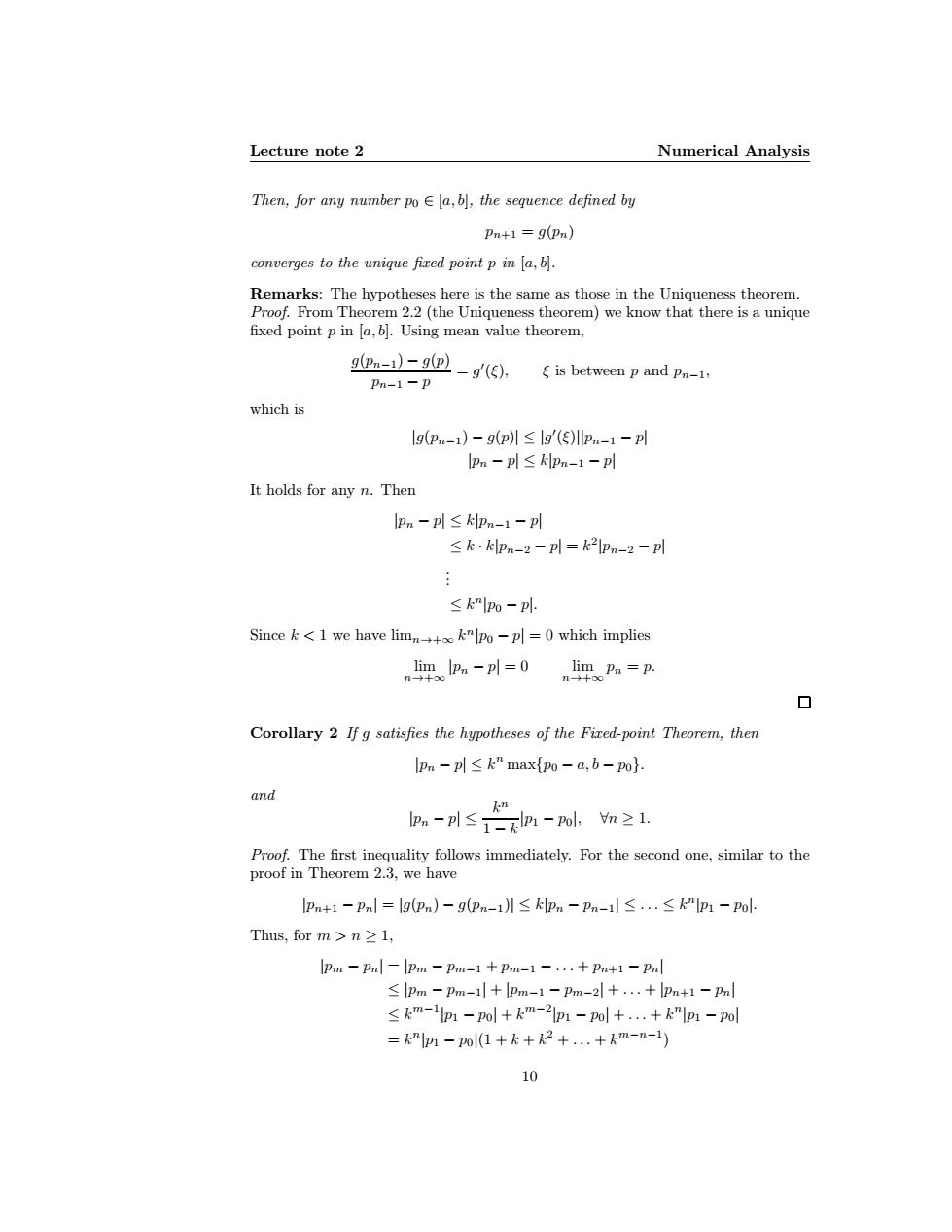正在加载图片...

Lecture note 2 Numerical Analysis Then,for any number po E la,b],the sequence defined by Pn+1=g(Pn) converges to the unique fired point p in a,b. Remarks:The hypotheses here is the same as those in the Uniqueness theorem. Proof.From Theorem 2.2 (the Uniqueness theorem)we know that there is a unique fixed point p in [a,b].Using mean value theorem, g-小=g2=g(), ξis between p and pn-l, Pn-1-P which is lg(pn-1)-g(pl≤lg(ξllpn-1-pl lpn-pl≤klpn-1-pl It holds for any n.Then lpn-pl≤klpn-1-pl ≤k·klpm-2-pl=k2pn-2-p刊 ≤klpo-pl. Since k<1 we have limnokpo-pl=0 which implies lim lpn -pl =0 lim Pn=p. n4+0 n¥+© 0 Corollary 2 If g satisfies the hypotheses of the Fired-point Theorem,then Ipn -p<k"max{po -a,b-po}. and kn lpm-刊≤-pn-pol,n≥1. Proof.The first inequality follows immediately.For the second one,similar to the proof in Theorem 2.3,we have lpn+1-pnl=lg(pn)-gpn-il≤klpn-pmn-il≤..≤k"lp1-pol Thus,form>n≥1, IPm Pnl=Pm Pm-1 Pm-1-...Pn+1-Pnl pm Pm-1l+lpm-1-Pm-21+...+pn+1 -Pnl km-ilpi -pol +km-2p1-pol+...+k"lpi -pol =k"p1-pol(1+k+k2+..+km--1) 10Lecture note 2 Numerical Analysis Then, for any number p0 ∈ [a, b], the sequence defined by pn+1 = g(pn) converges to the unique fixed point p in [a, b]. Remarks: The hypotheses here is the same as those in the Uniqueness theorem. Proof. From Theorem 2.2 (the Uniqueness theorem) we know that there is a unique fixed point p in [a, b]. Using mean value theorem, g(pn−1) − g(p) pn−1 − p = g ′ (ξ), ξ is between p and pn−1, which is |g(pn−1) − g(p)| ≤ |g ′ (ξ)||pn−1 − p| |pn − p| ≤ k|pn−1 − p| It holds for any n. Then |pn − p| ≤ k|pn−1 − p| ≤ k · k|pn−2 − p| = k 2 |pn−2 − p| . . . ≤ k n |p0 − p|. Since k < 1 we have limn→+∞ k n|p0 − p| = 0 which implies lim n→+∞ |pn − p| = 0 lim n→+∞ pn = p. Corollary 2 If g satisfies the hypotheses of the Fixed-point Theorem, then |pn − p| ≤ k n max{p0 − a, b − p0}. and |pn − p| ≤ k n 1 − k |p1 − p0|, ∀n ≥ 1. Proof. The first inequality follows immediately. For the second one, similar to the proof in Theorem 2.3, we have |pn+1 − pn| = |g(pn) − g(pn−1)| ≤ k|pn − pn−1| ≤ . . . ≤ k n |p1 − p0|. Thus, for m > n ≥ 1, |pm − pn| = |pm − pm−1 + pm−1 − . . . + pn+1 − pn| ≤ |pm − pm−1| + |pm−1 − pm−2| + . . . + |pn+1 − pn| ≤ k m−1 |p1 − p0| + k m−2 |p1 − p0| + . . . + k n |p1 − p0| = k n |p1 − p0|(1 + k + k 2 + . . . + k m−n−1 ) 10